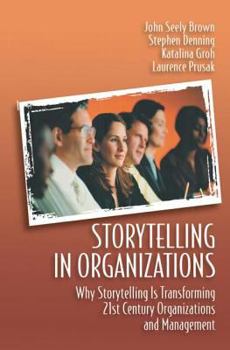Storytelling in Organizations
Select Format
Select Condition 
Book Overview
This book is the story of how four busy executives, from different backgrounds and perspectives, were surprised to find themselves converging on the idea of narrative as a valuable lens for understanding and managing organizations. The authors describe the power of narrative and storytelling in their own experience working on knowledge management, change management, and innovation strategies in organizations such as Xerox, the World Bank,...
Format:Paperback
Language:English
ISBN:0750678208
ISBN13:9780750678209
Release Date:August 2004
Publisher:Routledge
Length:208 Pages
Weight:0.80 lbs.
Dimensions:0.5" x 6.0" x 9.0"
Customer Reviews
2 ratings
Stories for Business and for Life
Published by Thriftbooks.com User , 16 years ago
The word storytelling evokes soft, touchy-feely emotions about family, friends, and yesteryear. What do any of these things have to do with organizations? If you allow yourself to get past the title you'll find that storytelling has a lot to do with how things get done in organizations, big and small. The authors will convince you that stories have been underutilized tools for organizational development and behavior change, but the growth and interest in storytelling is expanding dramatically, and the benefits can be quite dramatic. These are the types of people who know organizations and big business. Represented in the quartet of authors are former leaders at Xerox, The World Bank, IBM, and New World Entertainment. John Seely Brown, Stephen Denning, Katalina Groh, and Laurence Prusak are all heavyweights in their own spheres and perhaps the leading advocates on the storytelling in organizations. These are business leaders, not academics selling the idea of storytelling. The examples from and the relevance to business are what make "Storytelling in Organizations: Why Storytelling is Transforming 21st Century Organizations and Management" a book you're compelled to not only read, but use. While there are more than just business examples in the book, people will be most impressed how some of the largest enterprises run on something that seems so trivial: stories. "Storytelling" describes the history, impediments, successes, and the very human nature of this art. The book is so wide in scope of information and has such a strong impact on both a cognitive and emotional level, it was difficult to find much negative in it. However, this is not a perfect read. For example, some of the ideas and concepts developed and associations made in the book are difficult to agree with. Yet, none of the imperfections diminish the overall message or success of the work. While it is certainly not a panacea, the book does offer a different perspective to gather and sustain knowledge and implement change. At a minimum, "Storytelling" is entertaining and thought provoking. Any of the great thinkers or other authors mentioned should stimulate you to do further reading.
Why organizational storytelling is more than a fad
Published by Thriftbooks.com User , 19 years ago
The book offers two different timeframes -- the authors' speeches from the Smithsonian symposium on storytelling in April 2001 and their thoughts today, in 2004 -- and the book's value resides in showing what's changed and what hasn't in those three years. I found the 2004 "reflection" sections particularly valuable, since they make clear that storytelling turned out to be far more than the fad many feared it would become in 2001. Especially useful are John Seely Brown's reflections -- including his discussions of "knowledge ecologies." The bibliography and the endnotes to each chapter also help map the landscape of a field that is, in Stephen Denning's words, "widening and deepening."





